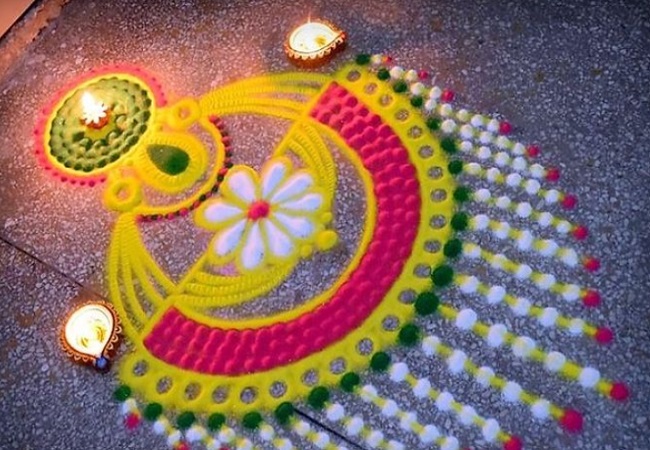With Diwali right around the corner, Rangoli designs will start being shared on Whatsapp groups and on Social Media. Ornate rangoli patterns and designs are an essential part of all Hindu rituals, including the upcoming Diwali celebrations. So, we thought why not spend some time telling the history of Rangoli and why it is such a vital part of everyone’s favourite Festival of Lights.
It is a traditional art style from India, which precedes even the classical arts of sculpture and painting. The name “Rangoli” originates from the Sanskrit term— Rangavalli. In this art, designs are drawn on the ground using powders of coloured rice or stone dust, red brick powder or flour. Floral rangolis are designed using flowers, leaves, and petals.
Rangoli is also called kolam, ossa, muggu or alpona in different states of India. These patterns are traditionally designed for events and occasions, from festivals to weddings.
The Underlying Philosophy
In Diwali, the patterns are embellished with diyas and lanterns to signify the triumph of light over darkness and evil. Rangolis are a way to welcome the Hindu Gods, and it is thought that Gods like to enter places where rangolis are drawn. Though they add a touch of beauty, they are primarily considered to invite in prosperity and good luck.
It is usually depicted with elaborate and intricate designs in a spectrum of colours at the doors or the outer courtyards. During Diwali, Goddess Lakshmi is said to enter the homes of devotees, and the rangoli is drawn to welcome her in.
A rangoli is also believed to guard homes and prevent evil qualities from entering. The negativity that surrounds a house is thought to get entangled in the elaborate patterns of the rangoli. This is the main idea behind the complicated and intricate designs.
Rangolis also function as a motivation for positive thinking to encourage us to lead a prosperous life. The two primary objectives for creating Rangolis are to invoke devoutness or auspiciousness and to produce beautiful aesthetics.

The Rangoli Designs
The patterns are diverse and vary from pure geometric patterns, flowers and petals, to highly complicated impressions of deities. There is no constraint on the shape or size of a rangoli. Rangolis can also be created together by a group of people, especially in the famous festivals of Ganpati Festival and Diwali.
In ancient India, Rangoli was considered a family tradition, and a way to bring the whole family together. Whatever the size of the patterns, Indian celebrations like Diwali and Pongal are not celebrated without a Rangoli. Also, the patterns alter to reflect traditions, customs, and folklore unique to the different areas of India.
Different motifs are used on various festivals and occasions. The design includes diyas, lamps, lotuses on Diwali or the Ganesha, Om symbol, during the Ganpati festival. But some patterns stay the same throughout the creations like the Swastik and foot symbols for Goddess Lakshmi.
Many patterns are passed down from generation to generation. The system has served to preserve the art form, the tradition, and the stories behind it.